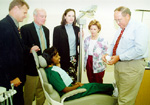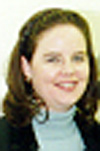New dental implant program planned
by Cindy AbolePublic Relations
One area of restorative dentistry that’s hot and in demand is dental implants. Determined to assure that its students are provided with the most up-to-date information, MUSC’s College of Dental Medicine is stepping up its training of young dentists in this field.
 Sulzer-Calcitek
representative Todd Metts, left, and University of Texas Health Science
Center’s Dr. Fred Bell joins MUSC’s Dr. Monica Cayouette and dental assistant
Peggy Bull as Dr. James Rivers reviews the implant process with Tina Gethers.
Sulzer-Calcitek
representative Todd Metts, left, and University of Texas Health Science
Center’s Dr. Fred Bell joins MUSC’s Dr. Monica Cayouette and dental assistant
Peggy Bull as Dr. James Rivers reviews the implant process with Tina Gethers.
No longer experimental, dental implants have edged ahead as a preferred option for people needing to replace missing teeth. Thanks to industry improvements and scientific study over many years, dental implants have proven to be very successful.
“Implants can significantly improve the quality of life for many people,” said James Rivers, DMD, professor and chairman of the Department of Prosthodontics, College of Dental Medicine.
In May 1999, the American Dental Association reported that the number of Americans who choose dental implants as a restorative dental option has tripled. In addition, as the list of implant users grow, so does the need for more skilled dental practitioners to perform them.
“Within the past 25 years, there’s been an explosion of new knowledge and materials used in dentistry,” Rivers said. “That’s why it’s important to keep our dental education program on the cutting edge.”
MUSC’s program was created in response to a request from faculty, staff, undergraduate students and residents interested in gaining more experience in implant dentistry. Recently, Rivers coordinated with Fred Bell, DMD, director of the dental implant program at the University of Texas Health Science Center in San Antonio, Texas.
The dental implant training program at the University of Texas is recognized as one of the best in the nation. Rivers plans to follow many of the recommendations by Bell. Over time, these efforts are expected to place MUSC among a group of leading dental schools who offer training and provide a contemporary dental curriculum that’s meeting with technological advances and community needs.
Attempts to use dental implants to replace missing teeth date back to the earliest recorded evidence of dental treatment. Unfortunately, the majority of these efforts were not scientifically based. During the past 75 years, adequate scientific study has been accomplished to generate a volume of research and clinical experience to support the safe and effective use of dental implants.
P. I. Branemark, M.D., Ph.D., a Swedish orthopaedic surgeon and researcher, is recognized as the developer of the implant design primarily used in today’s dental procedures. His research efforts began in the 1950s in Sweden and were used for patient treatment by the mid 1960s. His specific technique and implant design were introduced in the United States in the early 1980s.
Although many variations exist today, the basic principles of his research efforts are still used. It should be noted that many U.S. dentists successfully treated patients with other implant designs prior to 1980. But the earlier designs had many limitations that have been eliminated with the latest designs and techniques.
“Over the past 20 years, implants have demonstrated long-term success,” Rivers said. “This success can be attributed to the use of biologically sound surgical and restorative techniques used by highly skilled and appropriately trained dentists.”
Historically, implant procedures have been performed by dental specialists such as periodontists, oral and maxillofacial surgeons, and prosthodontists. The procedures may also be performed by general dentists who have received additional training. Many general dentists prefer to have the periodontist or oral surgeon place the implant. It should be noted that any licensed dentist who obtains adequate training can place and restore implants.
Accredited dental schools must comply with the American Dental Association (ADA) standards for dental education. Formal implant training in dental schools has been limited primarily to the graduate or specialty programs.
The requirement for undergraduate student implant education was limited and did not require clinical experience. Those educational requirements are rapidly changing, and all dental schools must eventually respond to these new educational demands.
The College of Dental Medicine’s 1998 retreat explored the need for a clinical, hands-on education program for the restoration of dental implants at the undergraduate level. Following the retreat, Rivers began making plans for meeting the needs for dental implant education in the College of Dental Medicine. Dental Medicine Dean, Richard DeChamplain, DMD, and his administration support the education program concept. Durwood Bach, DDS, chairman of oral and maxillofacial surgery and Jack Sanders, DDS, chairman of stomatology, have extensive experience in the surgical placement of implants and provide an extremely valuable part of the education program.
“Dental implant education has become a vital part of dental education,” said DeChamplain. “In the past, this level of training was concentrated in the graduate programs. It’s important that our graduates have the knowledge and expertise necessary to provide their patients with the most appropriate treatment. We’re excited that MUSC has the opportunity to become a leader in dental implant education for undergraduate dental students.”
Since 1991, implant education had been taught as a core course to senior students in the spring semester just before graduation with no clinical experience. Beginning in the 2000 academic year, junior students will be taught implant restorative procedures to prepare them to provide this treatment as part of their clinical education experience.
Within the past decade, implant manufacturers have taken an active role in supporting education for practicing dentists and dental students. In the past, the majority of support went to the graduate and specialty education programs. Those efforts are now moving into the undergraduate education programs. Organizations that bring together the most outstanding dentists in the world are also supporting the efforts. The International Congress of Oral Implantologists and the Academy of Osseointegration are two such organizations that are working with the efforts of implant manufacturers.
One of the leading implant companies, Sulzer-Calcitek, offers a program to support the development and ongoing process of the education program to undergraduate students. “We will work closely with this company to develop an outstanding education program for our students,” Rivers said.
“We’re in the midst of an exciting time in dentistry,” Rivers said. “We’re developing and using newer materials and technologies in all areas of dentistry that will provide better dental care for our patients. We’re looking forward to the College of Dental Medicine being a leader in many of the areas of education for these materials and technologies.”
What is a dental implant?
The dental implant serves as a foundation for the replacement of teeth.
Today's dentistry and dental implants
Millions of Americans are missing one or more of their natural teeth.
A major goal of dentistry has always been to replace these missing teeth
in the most suitable method available. Historically, this replacement has
been done with the use of dentures or removable partial dentures. Individuals
who have an adequate number of remaining healthy teeth can often be treated
with fixed bridgework. Bridges are a very successful method of dental treatment
but there are limitations. Dental implants can overcome many of these limitations
and provide better patient satisfaction.
How do dental implants work?
Dental implants provide support for restorations that replace missing
teeth. The implants are made of metal or ceramic material and are placed
directly into the jawbone. After the surgical placement of the implant,
a healing process, called osseointegration, takes place. Osseointegration
is the term used to identify the direct connection between the bone and
the implant. This process between bone and implant is essential for the
implant to be successful. Special surgical techniques are utilized to provide
a healthy result. After the appropriate healing time, restorations are
attached to the implants.
There are several ways in which restorations can be attached. New replacement teeth can be attached to the implants so that only the dentist can remove them. Implants can be utilized to anchor a permanent bridge by attaching to implants on one end and natural teeth on the other end or using implants for total support. Removable dentures can be secured to implants utilizing snaps, bars, clips or magnets. This method provides solid support for the denture but gives the patient the option of removing the appliance for cleaning.
Are dental implants for everyone?
Most people who are missing teeth can have dental implants. Certain
existing medical conditions may prevent implant use. A careful clinical
evaluation must be performed to determine if a person is a good candidate.
The examination must include X-rays to evaluate the condition of the existing
bone. There must be adequate supporting bone for the implants. Special
surgical techniques are available to enhance the bone if necessary.
The treatment procedure
Usually, the complete treatment involves a team approach. A surgeon
will place the implants and a restorative dentist will place the restorations
that are constructed by a dental laboratory technician. The complete treatment
with implants usually includes three phases.
During phase one the surgeon places the implants into the bone, generally done with local anesthesia along with light sedation. The surgery involves a small incision in the gum and drilling a small hole into the bone. The implant is placed into the hole and covered with gum tissue. There is some mild discomfort for one or two days following the procedure. The implants are then left undisturbed for several months: approximately three months in the lower jaw and six months in the upper jaw. The patient wears a temporary dental appliance during the osseointegration time.
After an adequate healing time, phase two treatment is accomplished to uncover the implants using a small incision in the gum directly over the implant. It is examined and a small metal post is placed in the implant. The metal post extends up through the gum and will be used to attach the dental restoration. The gum tissue around the post is given 2-3 weeks to heal.
Phase three involves several appointments to make impressions and fit
the restorations. The restorative dentist will utilize the material best
suited for providing aesthetic, healthy restorations. Also, during phase
three the patient is given extensive training concerning proper cleaning
and care of the implants as well as restorations. When the restorative
phase is complete, the patient is placed on a regular recall schedule with
the dentist. Proper oral hygiene by the patient is one of the most
critical steps for long term success of the dental implants.
Dental alumnus rooted in implant program
 With
the support of College of Dental Medicine Dean Richard DeChamplain,
Department of Prosthodontics chairman James Rivers has hired prosthodontist
Monica
Cayouette, DMD, to help accomplish goals set by the new dental
implant program.
With
the support of College of Dental Medicine Dean Richard DeChamplain,
Department of Prosthodontics chairman James Rivers has hired prosthodontist
Monica
Cayouette, DMD, to help accomplish goals set by the new dental
implant program.
Cayouette received her dental degree from MUSC in 1996 and earned her master’s degree in prosthodontics at the University of Texas Health Science Center, San Antonio, Texas, in June 1999.
Cayouette and dental assistant Peggy Bull will assist Rivers in training undergraduates to learn implant procedures at the college’s oral rehab clinic.
“Dr. Cayouette brings with her the latest scientific concepts and technology learned at one of the leading dental schools in the nation, and she is a tremendous asset to our program,” said Rivers.
“My first year will be devoted to getting the program organized,” said Cayouette of her new role. “There are more people in South Carolina asking about the benefits of dental implants. It’s part of our mission to provide education to dentists to offer these services to their patients.”